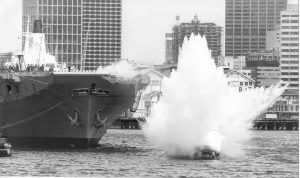- Author
- Haynes, Fred
- Subjects
- Naval Aviation, Naval technology
- Tags
-
- RAN Ships
- HMAS Melbourne II, HMAS Sydney III
- Publication
- December 2011 edition of the Naval Historical Review (all rights reserved)
This article is by Fred Haynes who for many years worked at Garden Island Dockyard firstly as a Scientific Instrument Maker and later as Technical Officer in charge of the Optical and Periscope Workshop. After 36 years at GID Fred served another 9 years as an Assistant Curator at the Naval Heritage Centre collection at Spectacle Island.
In the Fleet Air Arm different aircraft were unofficially rated by their pilots for their takeoff performance on the catapult. This was the ability to become airborne after launch, or being ‘pitched’. Performance of individual aircraft varied greatly and sometimes for some reason flight could not be maintained. This invariably meant the aircraft would crash or ‘ditch’ in the sea. The ratio of successful launches to failure was colloquially called the ‘pitched and ditched record’.
When the RAN took delivery of HMAS Melbourne it came fitted with the latest developments in naval aviation technology including the British designed steam catapult, angled flight deck and mirror landing system. In fact it was the decision to fit these to Melbourne that resulted in her delivery being delayed. Both HMAS Sydney and Melbourne were laid down as Majestic Class light fleet carriers towards the end of WW II but only Sydney was completed and commissioned as HMS Terrible. The uncompleted second ship was laid up at the end of hostilities and remained incomplete until the decision by the RAN to acquire two carriers for its new Fleet Air Arm. It was also decided to acquire a third carrier HMS Vengeance on loan from the RN until Melbourne was completed.
The newly acquired HMA Ships Sydney and Vengeance aircraft were Hawker Sea Fury FB11 and Fairey Firefly 5. Both these aircraft were catapult launched and often relied on JATO rockets for necessary additional thrust for takeoff when fully loaded. While these ships required conventional skills for refit maintenance of their hulls and propulsion systems the maintenance of their catapults presented new challenges for Garden Island Dockyard.
Catapults previously fitted to RAN ships such as the cruisers Australia, Hobart and Sydney used either compressed air or cordite charges. The aircraft sat on a cradle fitted to the catapult and required a crane to lift them into position prior to launch. The usual method for testing was to fire a large test baulk of wood to simulate the weight of the aircraft.

Young and Jackson’s
The new carriers required a different method of testing catapults leading to the design of a re-useable four wheeled test vehicle which the Dockyard called ‘Sadie.’ Sadie was used during the active service lives as RAN carriers Sydney and Vengeance. When Melbourne was introduced with her modified design she was able to launch the later jet powered de Havilland Sea Venom FAW53 and twin turboprop Fairey Gannet AS1 and 4. Sadie was no longer able to cope with these new requirements and a new test vehicle was built, fitted with a four wheel undercarriage from a Canberra jet bomber It contained ballast tanks that could be filled with water to simulate different aircraft weights.
The new vehicle was christened ‘Chloe’ after the famous painting in the landmark Young & Jackson’s Hotel in the ship’s namesake city. Testing was conducted when the ship was alongside resulting in a large splashdown up to 200 metres ahead of the ship. The float was then lifted back onboard with the aid of the 250 ton hammerhead crane. On one occasion a commercial fisherman returning to the then commercial Woolloomooloo Bay ignored repeated warnings and was distraught when covered in spray after Chloe landed alongside.
Following Melbourne’s 1967 – 1969 major refit came new aircraft, the Douglas A4G Skyhawk and Grumman S2 Tracker. This required an upgrade of Chloe with saddle tanks added to reflect increases in weight, but this upset the test vehicle’s already pedestrian aerodynamics. Accordingly another test vehicle was introduced comprising a steel girder frame forming a sled plus a large cylindrical tank for ballast water. The sled was not fitted with wheels but had two wooden skids. This produced unpredictable and spectacular results and as a result use of this unloved and unnamed test vehicle was discontinued shortly after its introduction. Both Chloe and her unnamed successor were last seen in a derelict condition at the old Rydalmere Naval Stores. Certainly Sadie and Chloe held the record of 100% pitched and ditched in RAN service.





